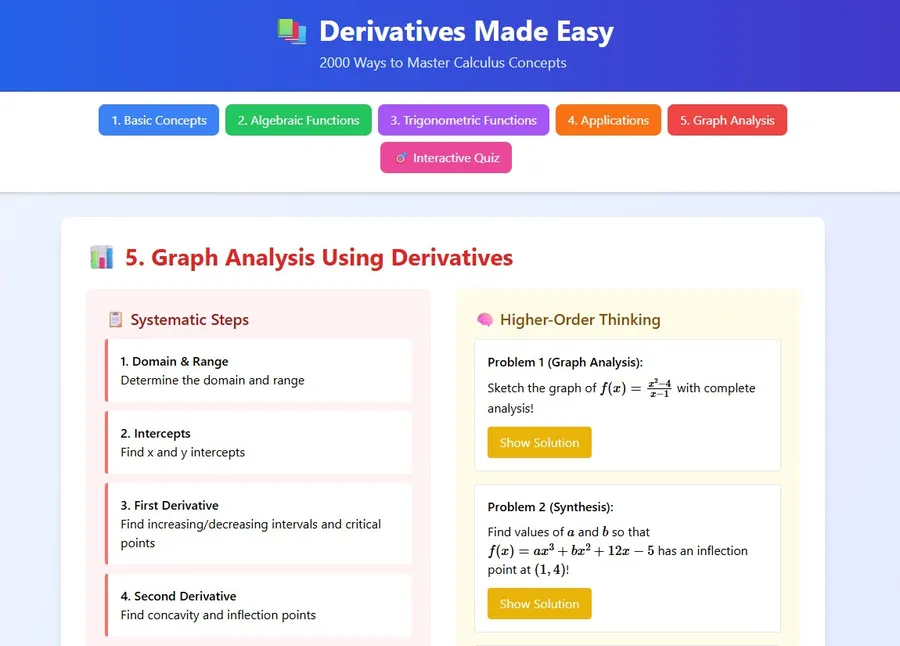Learn how to sketch and interpret derivative graphs, analyze function behavior, and solve calculus problems visually with guided examples.
Table Of Contents
📘 Graphing Functions Using Derivatives
Master the Art of Sketching Accurate Function Graphs with Derivatives
🎯 Why Use Derivatives to Sketch Graphs?
Plotting graphs just by plugging in values is time-consuming and often inaccurate. With derivatives, you can:
- Know where a graph goes up/down (increasing/decreasing)
- Locate local maxima or minima
- Identify points of inflection
- Analyze concavity
- Understand asymptotic behavior
This makes curve sketching faster, clearer, and more reliable.
🪜 Step-by-Step Strategy for Sketching Functions
To sketch a function :
- Domain: Determine where is defined
- Intercepts: Find and where
- Critical Points: Solve
- Increasing/Decreasing: Analyze sign of
- Concavity: Use to determine concave up/down
- Inflection Points: Solve
- Asymptotes: Check vertical/horizontal/oblique behavior
- Sketch: Plot and connect behavior
🔍 Example 1: Graph
Domain: All real numbers
Intercepts:
- → y-intercept
- Solve
First Derivative:
- (critical points)
Sign of :
- → positive
- → negative
- → positive → So, increasing → decreasing → increasing → Max at , min at
Second Derivative:
- → possible inflection point
- Concave down when , up when
Inflection Point:
No Asymptotes
Sketch: Use all this data to create a smooth graph
✅ Final Shape: An “S” curve crossing the x-axis at three points, turning at x = ±1, inflecting at x = 0.
📉 Example 2: Sketch
Domain: All real numbers
Intercept:
First Derivative:
Set → critical point
- → Max at
Second Derivative:
Set → inflection points
Asymptotes:
- No vertical (denominator never zero)
- Horizontal as ,
✅ Shape: Bell curve with max at (0,1), decreasing toward 0 on both sides, with inflection points at
🧠 Tips for Students
- Critical points help find peaks and valleys
- Second derivative shows whether the curve opens up or down
- Always label key points before sketching
- Don’t forget asymptotes in rational functions
- Check endpoints if the domain is restricted
💡 HOTS Problem
Let
Sketch its graph using:
- First derivative for increasing/decreasing
- Second derivative for concavity
- Find intercepts and asymptotes
🧠 Solution Outline
- Intercept:
- First Derivative: Use quotient rule
- Second Derivative: Analyze using sign
- Horizontal asymptote? As , → no horizontal asymptote
- Sketch based on all features
🧪 Practice Problems
🔹 Standard
- Sketch
- Sketch
- Sketch
🔥 HOTS
Sketch
Sketch a piecewise function:
$$ f(x) = \begin{cases} x^2 & \text{if } x < 1 \
2x - 1 & \text{if } x \geq 1 \end{cases} $$
📌 Summary Table
| Feature | How to Find |
|---|---|
| Critical points | Solve |
| Increasing/Decreasing | Analyze sign of |
| Maxima/Minima | Use First or Second Derivative |
| Inflection points | Solve |
| Concavity | : up, < 0: down |
| Asymptotes | Analyze limits or denominator |
